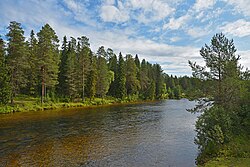Ѣмьцꙗ
Hello, you have come here looking for the meaning of the word Ѣмьцꙗ. In DICTIOUS you will not only get to know all the dictionary meanings for the word Ѣмьцꙗ, but we will also tell you about its etymology, its characteristics and you will know how to say Ѣмьцꙗ in singular and plural. Everything you need to know about the word Ѣмьцꙗ you have here. The definition of the word Ѣмьцꙗ will help you to be more precise and correct when speaking or writing your texts. Knowing the definition ofѢмьцꙗ, as well as those of other words, enriches your vocabulary and provides you with more and better linguistic resources.

Ѣмьцꙗ
Old Novgorodian

Etymology
Probably from ѣмь (jěmĭ, “name of a Finno-Ugric tribe from the northern coast of Ladoga”) + -ьцꙗ (-ĭćja), a variant of ꙗмь (jamĭ, “Tavastian”). Borrowed from Finnic languages, such as Finnish Häme (“Tavastia”), ultimately from Proto-Finnic *hämä. Compare Old East Slavic Ѣмьца (Jěmĭca), Russian Е́мца (Jémca).
Pronunciation
- Hyphenation: Ѣ‧мь‧цꙗ
Proper noun
Ѣмьцꙗ • (Jěmĭćja) f
- Yemtsa (a river in the Novgorod Republic, Kievan Rus)
- c. 1050 – 1080, Wooden cylinder seal no. 1, Novgorod (Nerevsky excavation):
- Ѣмьцѧ гривны ·г·
- Jěmĭćę grivny ·g·
- Yemtsa (river). 3 hryvnia.
- Ѣмьцѧ гривны ·г·
- c. 1000 – 1100, Wooden cylinder seal no. 5, Novgorod (Legoshchensky excavation):
- …ъча ·ї· гривънъ
- …ŭća ·i· grivŭnŭ
- Yemtsa (river ?). 10 hryvnia.
- …ъча ·ї· гривънъ
- c. 1100 – 1200, Counting tag “Ust-Yemtsa”, Novgorod (Troitsky excavation):
- ꙋстье Ѣмьцѣ
- ustĭje Jěmĭćě
- Ust-Yemtsa .
- ꙋстье Ѣмьцѣ
Derived terms
proper nouns
- Оустьѥ Ѣмьцꙗ (Ustĭje Jěmĭćja) (toponym)
Descendants
References
- ^ Vasmer, Max (1973) “ямь”, in Oleg Trubachyov, transl., Этимологический словарь русского языка (in Russian), volumes 4 (Т – Ящур), Moscow: Progress, page 557
Further reading
- “Ѣмьца”, in “East Slavic Epigraphy (Inscriptions) Corpus”, in Russian National Corpus, https://ruscorpora.ru, 2003–2025
